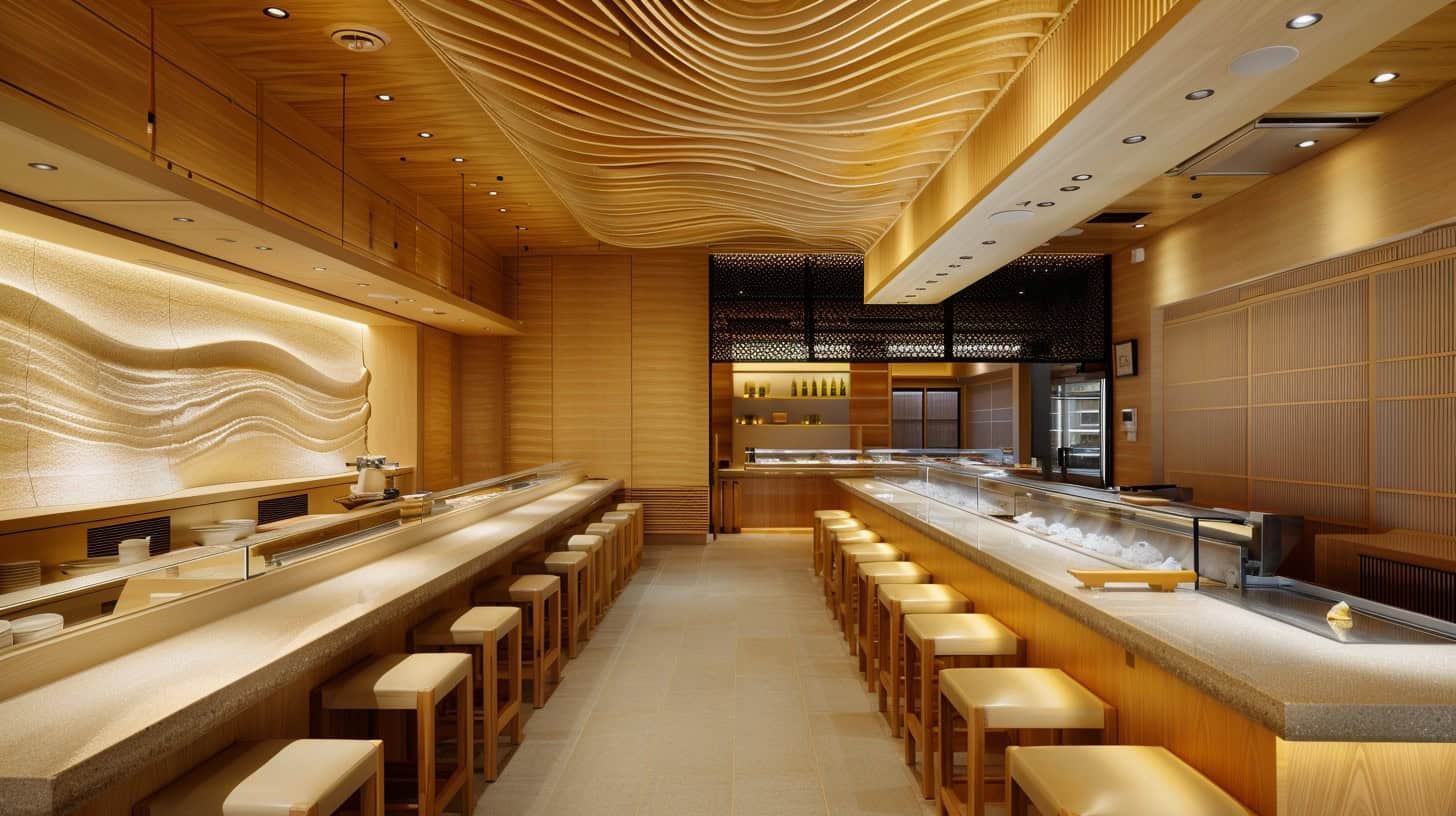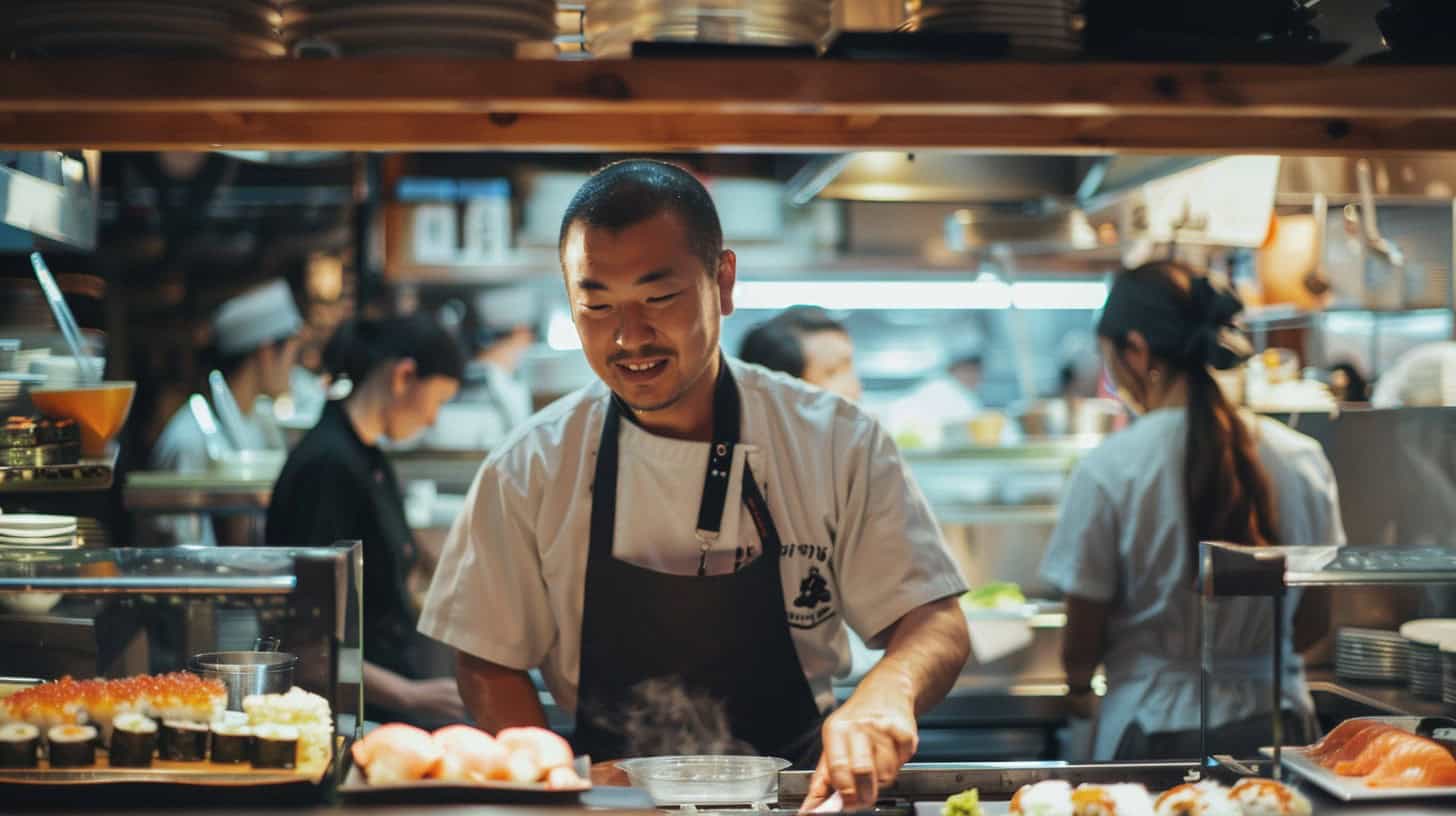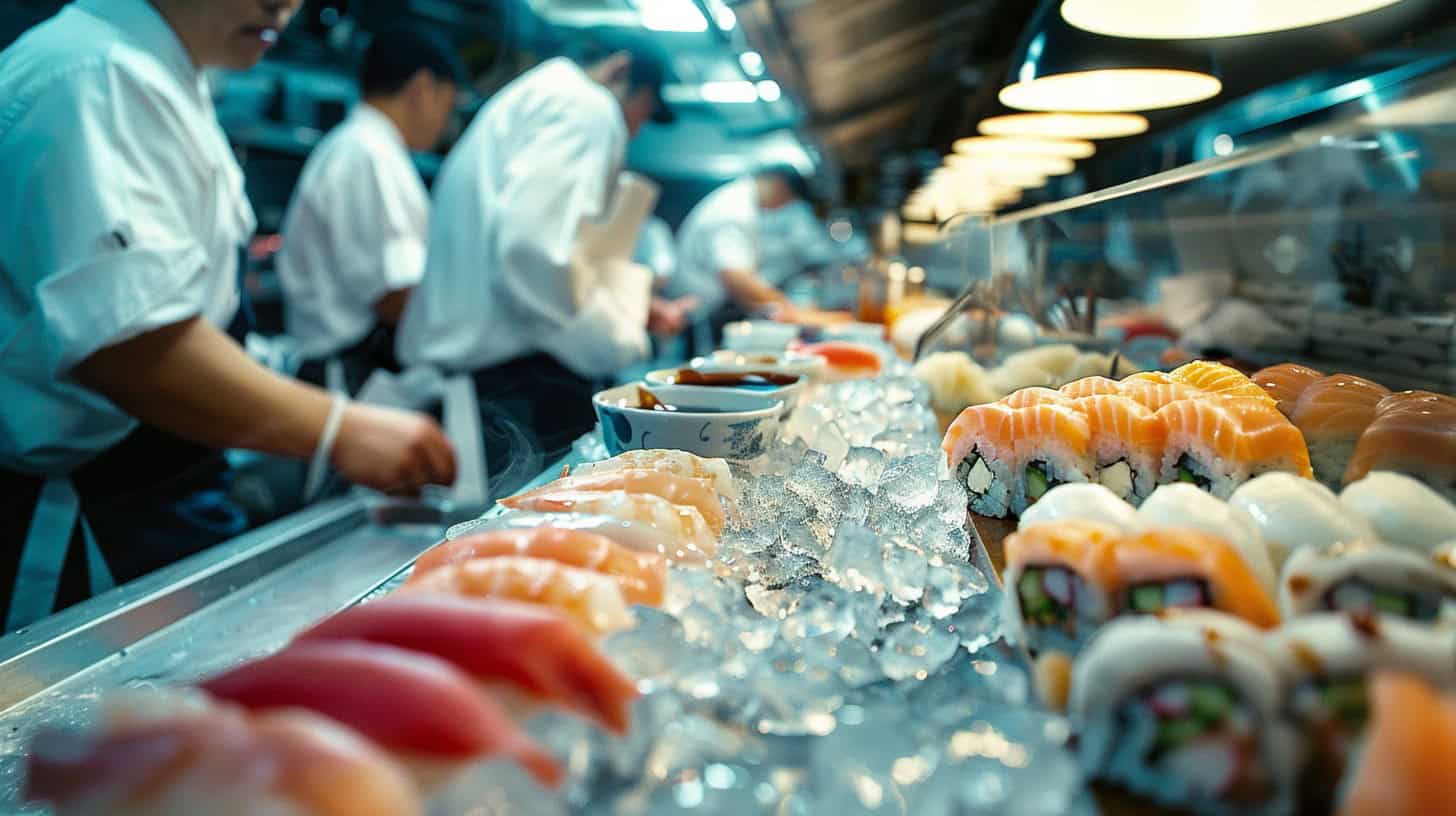Opening a sushi restaurant demands more than just great food. It requires a solid business plan, top-notch staff, and quality ingredients. Many aspiring restaurateurs underestimate the importance of technology in today’s market.
Self-ordering kiosks and digital signage are now essential for success. These tools boost efficiency and enhance customer experience. 3
From choosing the right location to crafting a unique menu, we cover it all. Get ready to turn your sushi dreams into reality. 2
Key Takeaways
A successful sushi restaurant requires a solid business plan, quality staff, fresh ingredients, and modern technology like self-ordering kiosks.
The average cost for essential restaurant equipment ranges from $20,000 to $150,000, with sushi counters costing $15,000 to $40,000.
Hiring an experienced sushi master chef (itamae) with 5–10 years of experience is crucial for crafting authentic Japanese cuisine.
Self-service kiosks and online ordering systems can boost efficiency, increase average check sizes, and improve the customer experience.
Effective marketing strategies include leveraging social media platforms like Facebook and Instagram, where 89% of U.S. diners have accounts, and organizing a grand opening event with 3-12% of revenue allocated for promotion.
Table of Contents
Developing Your Sushi Restaurant Business Plan

Your sushi restaurant’s business plan is the blueprint for success. It outlines your vision, target market, and financial projections – crucial for securing funding and guiding your operations.
Identifying Your Ideal Customers
Defining your target customer is crucial for a successful sushi restaurant. The Sushi Place, located in Bryant Park, focuses on residents and tourists in the area. 1 Office workers are a key demographic, prompting the restaurant to offer lunch specials.
Analyze local demographics, income levels, and dining preferences to refine your customer profile. Consider factors like age range, cultural background, and eating habits to tailor your menu and marketing strategies effectively.
Geographic location plays a vital role in customer identification. Research the neighborhood’s foot traffic patterns, competing restaurants, and popular cuisines. Use social media analytics and local market research to gather insights on potential patrons’ preferences. 2 Create customer personas based on this data to guide your business decisions and menu development. Adjust your offerings and marketing approach as you learn more about your clientele’s tastes and behaviors.
Choosing Your Sushi Restaurant’s Name and Brand Identity
Choosing a name for your sushi restaurant sets the tone for your brand. Opt for something memorable, meaningful, and reflective of Japanese cuisine. Incorporate a story or cultural significance into the name – this adds depth and intrigue for potential customers.
Your logo and visual identity should complement the name, creating a cohesive brand image. 3 Design a mock-up menu that aligns with your chosen aesthetic. This package – name, logo, theme, and menu – forms the core of your presentation to investors.
Market research plays a crucial role in developing your brand identity. Understand local sushi demand and preferences to tailor your offering. This data informs not just your menu, but your overall branding strategy.
A well-crafted brand identity helps you stand out in a competitive restaurant landscape. It communicates your unique value proposition to potential diners and investors alike. 2
Planning Required Technology and Equipment
Planning your sushi restaurant’s tech and equipment is crucial. 87% of restaurants found technology vital for survival post-pandemic. 2 Self-ordering kiosks are a game-changer – 65% of customers prefer them.
They streamline ordering, boost upselling, and enable contactless payments. Essential equipment costs range from $20,000 to $150,000, with sushi counters running $15,000 to $40,000. 4
The right technology and equipment aren’t just tools – they’re the backbone of a successful sushi restaurant. – Masayoshi Takayama
Key tech includes point-of-sale systems, inventory management software, and online ordering platforms. For equipment, prioritize high-quality refrigerators, freezers, and rice cookers.
Don’t forget specialized sushi tools like bamboo mats and sharp knives. A reliable cold storage system is essential for food safety. Invest in energy-efficient appliances to cut long-term costs.
Legal Foundations for Your Sushi Restaurant

Setting up the legal framework for your sushi spot is crucial. You’ll need to pick a business structure and get the right papers in order.
Deciding on LLC or LP Business Structures
LLC and LP structures offer distinct advantages for sushi restaurant owners. LLCs provide minimal paperwork, low filing costs, and liability protection. 6 LPs can attract higher capital and financial security.
However, LLCs face high renewal fees in some states and spread ownership across members. LPs burden general partners with more risk and decision-making responsibilities.
Choosing between LLC and LP hinges on specific business goals. LLCs suit smaller operations seeking simplicity and personal asset protection. 5 LPs fit larger ventures needing substantial investment.
Consult a tax professional to determine the optimal structure for your sushi restaurant’s financial and operational needs.
Registering Your Business for Tax Purposes
Registering your sushi restaurant for tax purposes is a crucial step in establishing your business legally. Here’s a streamlined guide to navigate this process efficiently:
- Obtain an Employer Identification Number (EIN) from the IRS
- Register with your state’s revenue department for sales tax collection 6
- Set up a business bank account to separate finances
- Apply for a business credit card to track expenses
- File for local tax permits specific to food service establishments
- Implement accounting software to manage financial records
- Consult a tax professional for guidance on deductions and credits 2
- Register for payroll taxes if hiring employees
- Understand and comply with food safety regulations
- Keep detailed records of all business transactions for tax purposes
Obtaining Necessary Licenses and Permits
After registering your business for taxes, you’ll need to secure crucial licenses and permits. These documents ensure your sushi restaurant operates legally and meets all health and safety standards. 7
- State Business License: Apply through your state’s Secretary of State office. Costs vary by state.
- Employer Identification Number (EIN): Get this free from the IRS. It’s required for tax purposes and hiring employees. 8
- Foodservice License: Contact your local health department. Expect an inspection before approval.
- Liquor License: If serving alcohol, apply through your state’s Alcoholic Beverage Control board. Fees range from $300 to $14,000+.
- Health Inspection Certificate: Schedule with your local health department. They’ll check food safety practices and kitchen cleanliness.
- Building Permit: Needed for any renovations. Apply at your city’s building department.
- Sign Permit: Check local zoning laws before installing exterior signage.
- Music License: Required if playing copyrighted music. Contact BMI, ASCAP, or SESAC.
- Food Handler’s Permit: All staff handling food must obtain this. Training courses available online or through health departments.
Choosing the Ideal Location for Your Sushi Restaurant

Location makes or breaks a sushi restaurant. Target your ideal customers’ hangouts. Foot traffic, outdoor seating, and local vibe matter. Square footage impacts your setup options. 7
Consider demographics, visibility, and competition. Rent costs affect profitability. A spot with high visibility and easy access boosts success chances. Balance these factors for the perfect sushi spot. 4
Designing Your Sushi Restaurant Interior

The vibe of your sushi spot sets the tone for your customers’ experience. Your design choices can transport diners to Japan or create a modern fusion atmosphere.
Creating an Authentic Japanese Ambiance
Creating an authentic Japanese ambiance hinges on traditional design elements. Shoji screens, tatami mats, and calligraphy scrolls set the stage for a zen-like atmosphere. Bonsai trees and rock gardens add natural touches, transporting diners to a serene Japanese setting.
Wood, stone, and textiles play crucial roles in texturing the space. 9
Colors and lighting fixtures dramatically impact the overall mood. Soft, warm hues paired with dimmed lighting create an intimate dining experience. Strategically placed lanterns or pendant lights can highlight key areas, like the sushi bar or feature walls.
These elements combined craft a space that’s both authentic and inviting for sushi enthusiasts. 2
Simplicity is the ultimate sophistication in Japanese design.
Selecting Furniture and Decor
Choosing the right furniture and decor sets the tone for your sushi restaurant’s ambiance. Here’s a guide to selecting elements that create an authentic Japanese atmosphere while catering to modern tastes:
- Seating options: Shop for restaurant booths at restaurantfurnitureplus.com for comfortable, space-efficient seating. Mix in low tables with floor cushions for a traditional Japanese dining experience.
- Sushi bar design: Install a sleek, wooden sushi bar with built-in refrigeration units. Add high stools for customers who prefer watching sushi chefs in action.
- Lighting fixtures: Incorporate paper lanterns and bamboo pendant lights to create a warm, inviting glow. Use adjustable LED strips for accent lighting on sushi displays.
- Wall decor: Hang calligraphy scrolls and ukiyo-e prints to showcase Japanese art. Install Shoji screens as room dividers or window coverings for an authentic touch. 9
- Tableware selection: Choose ceramic plates, wooden serving boards, and bamboo chopstick rests. Opt for sake sets and tea cups in traditional styles to enhance the dining experience.
- Natural elements: Place bonsai trees and small rock gardens throughout the space. Use bamboo or reclaimed wood for accent walls and flooring to promote sustainability.
- Color scheme: Stick to a monochromatic palette with pops of red or gold for a modern, minimalist look. Incorporate natural textures like stone and wood to add depth.
- Functional decor: Display fresh fish in a glass case near the entrance. Install a digital menu board for easy updates and specials promotion. 10
Planning the Layout for Functionality and Aesthetics
After selecting furniture and decor, it’s time to plan your sushi restaurant’s layout. Functionality meets aesthetics in this crucial step. Consider traffic flow, kitchen efficiency, and customer comfort. 2
Place self-service kiosks strategically near entrances. Position the sushi bar centrally for optimal visibility. Create distinct zones for intimate dining and group seating. Incorporate traditional elements like shoji screens and bonsai trees to enhance ambiance. 9 Ensure proper lighting to highlight food presentation. Leave ample space between tables for waitstaff movement. Design an open kitchen concept to showcase your sushi master’s skills.
This layout maximizes both operational efficiency and dining experience.
Building Your Sushi Restaurant Team

Your sushi restaurant’s success hinges on a top-notch team. A skilled sushi chef and attentive waitstaff are key to creating an authentic Japanese dining experience.
Hiring a Sushi Master Chef
Hiring a sushi master chef is crucial for your restaurant’s success. This expert artisan, known as an itamae, brings years of training and skill to craft authentic Japanese cuisine. 2 Look for candidates with 5–10 years of experience in top sushi establishments. A true master can prepare konbini food-inspired dishes alongside traditional fare, showcasing versatility.
The ideal sushi chef possesses deep knowledge of fish quality, knife techniques, and rice preparation. They should demonstrate creativity in menu development while respecting classic flavors.
Passion for educating customers about sushi culture is essential. 11 During interviews, ask chefs to perform live demonstrations of their skills. This hands-on approach reveals their expertise and ability to work under pressure.
Recruiting Experienced Waitstaff
Recruiting experienced waitstaff is crucial for a successful sushi restaurant. Skilled servers enhance customer experience and boost sales. 4
- Look for candidates with Japanese dining or Asian cuisine background
- Offer competitive pay: $20,000 – $35,000 salary range
- Emphasize cultural knowledge and etiquette in job descriptions
- Conduct role-playing interviews to assess service skills
- Check references from previous Japanese or Asian restaurants
- Provide comprehensive training on sushi varieties and preparation methods 12
- Implement a mentorship program with senior staff
- Create clear career progression paths to reduce turnover
- Offer language classes for staff to improve communication with Japanese-speaking guests
- Use LinkedIn and industry-specific job boards for targeted recruitment
- Partner with culinary schools for a pipeline of trained professionals
- Implement employee referral programs with incentives
- Conduct regular performance reviews with opportunities for raises
- Offer flexible scheduling to accommodate student workers
Integrating Technology in Your Sushi Restaurant

Tech can make or break your sushi spot. Smart systems boost efficiency and customer satisfaction.
Implementing Self-Service Kiosks
Self-service kiosks in sushi restaurants streamline ordering and reduce wait times. These digital touchpoints boost order accuracy and enhance guest experiences. Strategic placement of kiosks is crucial – they should be visible yet not disruptive to the restaurant’s flow.
Monitoring kiosk performance helps optimize their use and identify areas for improvement. 13
Kiosks offer benefits for both customers and restaurant owners. They allow patrons to browse menus at their own pace, customize orders, and pay quickly. For restaurateurs, kiosks can increase average check sizes and free up staff to focus on food preparation and customer service.
Implementation requires careful planning, staff training, and regular software updates to ensure smooth operation. 14
Setting Up Systems for Online Orders
Moving from self-service kiosks to online ordering systems expands your reach. UpMenu offers a branded mobile app for quick food ordering. 15 This technology boosts revenue potential, with online food delivery projected to hit $339,257 million in 2022.
Creating your own system gives you full control over the process. 16 Implement secure payment gateways, real-time inventory tracking, and user-friendly interfaces. Ensure your website and app are optimized for mobile devices.
Integrate with your point-of-sale system for seamless operations. Train staff on order fulfillment procedures to maintain efficiency and customer satisfaction.
Preparing for the Launch of Your Sushi Restaurant

Launching a sushi restaurant takes careful planning. You’ll need to source top-notch ingredients and craft a menu that wows your customers.
Sourcing Quality Supplies and Tools
Quality supplies and tools are crucial for a successful sushi restaurant. Selecting the right items ensures consistency, efficiency, and authenticity in your culinary offerings. 2
- Develop relationships with reputable food distributors for fresh fish, seaweed, and specialty ingredients
- Identify a Japanese restaurant supply store for authentic kitchen equipment and serving ware
- Connect with a local ceramicist to create custom dishware that reflects your restaurant’s aesthetic
- Source high-grade sushi rice from trusted suppliers to maintain flavor and texture consistency
- Invest in professional-grade sushi knives, including yanagiba and deba, for precise cuts
- Purchase bamboo mats (makisu) for rolling sushi and temaki hand rolls
- Acquire a commercial rice cooker to maintain optimal rice texture and temperature
- Obtain a reliable refrigeration system to keep fish and ingredients fresh
- Invest in a quality sushi display case to showcase your creations and maintain proper temperature 4
- Procure eco-friendly chopsticks and other dining utensils to enhance the dining experience
- Source biodegradable takeout containers for environmentally conscious customers
- Acquire a point-of-sale system with inventory management features to track supplies
Crafting Your Sushi Menu
Crafting a stellar sushi menu is crucial for your restaurant’s success. Let’s dive into the key elements of creating a menu that’ll wow your geeky clientele:
- Showcase signature dishes: Highlight unique rolls that set your restaurant apart. Create 3-5 specialty rolls with catchy names like “Geek’s Delight” or “Byte-sized Bliss.” 3
- Organize by categories: Group sushi types logically – nigiri, maki, temaki, and specialty rolls. This structure aids quick decision-making for tech-savvy customers.
- Price strategically: Set normal rolls at $6.50 and specialty rolls at $12.60 on average. Offer a “Sushi Sampler” combo for indecisive patrons.
- Include traditional options: Feature classic rolls like California and Spicy Tuna. These staples cater to less adventurous diners.
- Incorporate tech-inspired names: Label dishes with geeky references like “Binary Bites” or “Firewall Fusion” to resonate with your target audience.
- Describe ingredients clearly: List all components in each roll. Use precise terms like “torched” or “tempura-fried” for clarity. 2
- Add vegetarian and vegan options: Create plant-based rolls using ingredients like avocado, cucumber, and sweet potato. Label them prominently for easy identification.
- Feature seasonal specials: Rotate menu items based on fish availability. This keeps your offerings fresh and encourages repeat visits.
- Highlight health benefits: Mention omega-3 content in fatty fish like salmon. Appeal to health-conscious geeks with nutritional facts.
- Include a sake pairing guide: Suggest ideal sake matches for each roll. This enhances the dining experience and boosts beverage sales.
- Offer customization: Allow guests to modify rolls or create their own. This caters to picky eaters and allergy concerns.
- Design a visually appealing layout: Use high-quality photos and clean typography. A well-designed menu improves order accuracy and speed.
- Incorporate Japanese culture: Include brief explanations of traditional sushi etiquette or fun facts about Japanese cuisine. This adds an educational element to the dining experience.
After finalizing your menu, focus on sourcing quality supplies and tools for your sushi restaurant.
Strategies for Marketing and Opening Your Sushi Restaurant
Marketing your sushi restaurant needs a smart plan. Social media and a big opening event can get people excited about your place.
Leveraging Social Media for Effective Promotion
Social media platforms are crucial for sushi restaurant promotion. Facebook, Instagram, and Twitter – the top three platforms used by restaurants – offer direct access to potential customers.
A staggering 89% of U.S. diners have at least one social media account, while 39% use these platforms to decide where to eat. 17
Effective strategies include sharing high-quality photos of sushi rolls, behind-the-scenes glimpses of chefs at work, and customer testimonials. Regular posts about daily specials, happy hour deals, or new menu items can drive engagement.
Responding promptly to comments and messages builds customer relationships and trust. Paid advertising on these platforms can also target specific demographics, increasing visibility among ideal customers. 18
Organizing a Memorable Grand Opening Event
Plan a grand opening extravaganza for your sushi restaurant. Host a soft opening and ribbon-cutting ceremony to engage the community. Allocate 3% to 12% of your revenue for marketing. 4 Create buzz with social media campaigns and local press coverage. Offer exclusive tastings of signature rolls to VIP guests and food critics. Set up interactive sushi-making stations for hands-on experiences.
Feature live entertainment like taiko drummers or shamisen players for authentic ambiance. 1 Provide special promotions or gift cards to early customers, encouraging repeat visits.
Ensure your staff is well-trained and ready to deliver exceptional service during this crucial first impression.
People Also Ask
What legal structure should I choose for my sushi restaurant?
Consider a limited liability corporation (LLC) or S corporation. These protect personal assets. Sole proprietorship is simpler but riskier.
How do I secure funding for my sushi restaurant?
Explore loans from banks, investments from venture capitalists, or partnerships. Create a solid business plan. Show financial projections using Excel spreadsheets.
What’s crucial for leasing a restaurant space?
Work with an estate agent. Negotiate lease terms carefully. Consider property taxes, utilities, and maintenance. Ensure compliance with food safety laws.
How do I create an effective menu for my sushi restaurant?
Plan diverse options – appetizers, main courses, desserts. Include popular items like stir-fry and grilled dishes. Use a wok range for versatility. Price items strategically.
What insurance do I need for my sushi restaurant?
Get workers’ compensation insurance, liability coverage, and property insurance. Protect against food waste and potential lawsuits.
How can I market my new sushi restaurant?
Develop a website and Facebook page. Run targeted advertising campaigns. Offer promotions on weekdays. Consider high-end options for premium customers.
References
- ^ https://www.upmenu.com/blog/sushi-restaurant-business-plan-sample/ (2024-04-24)
- ^ https://www.infi.us/post/how-to-open-a-sushi-restaurant
- ^ https://blog.osum.com/how-to-open-a-sushi-restaurant/ (2024-05-27)
- ^ https://dojobusiness.com/blogs/news/sushi-complete-guide (2024-02-11)
- ^ https://www.businessnewsdaily.com/8163-choose-legal-business-structure.html
- ^ https://howtostartanllc.com/business-ideas/sushi (2024-06-12)
- ^ https://www.katom.com/learning-center/so-you-want-to-start-a-sushi-business.html
- ^ https://finmodelslab.com/blogs/how-to-open/how-to-open-sushi-restaurant
- ^ https://innerunionhome.com/blogs/news/sushi-restaurant-interior-design-a-detailed-guide (2024-05-26)
- ^ https://scgwest.com/2020/06/01/designing-your-next-sushi-restaurant/
- ^ https://www.cozymeal.com/magazine/how-to-be-a-sushi-chef (2024-02-12)
- ^ https://maxima.com/en/blogs/maxima/opening-a-sushi-bar-heres-what-you-need-to-know-en/ (2022-10-26)
- ^ https://qikserve.com/7-steps-to-implementing-self-ordering-kiosks-in-your-restaurant/
- ^ https://www.researchgate.net/publication/358790565_The_adoption_of_self-service_kiosks_in_quick-service_restaurants
- ^ https://www.upmenu.com/blog/how-to-set-up-online-ordering-system/
- ^ https://www.infi.us/post/managing-restaurant-with-online-ordering (2022-05-19)
- ^ https://kickfin.com/blog/leveraging-social-media-marketing-restaurants-bars/
- ^ https://pos.toasttab.com/blog/on-the-line/examples-of-awesome-restaurant-social-media-marketing



